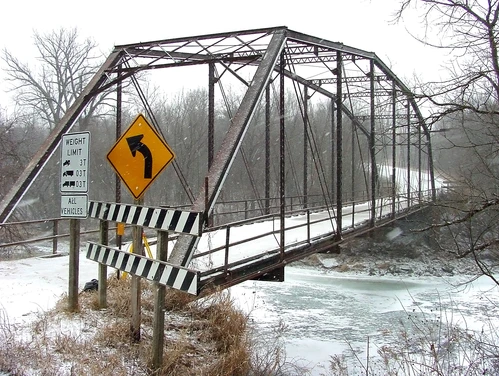- Year constructed: 1902
- Alternate name: Bone's Mill Bridge, Bever Bridge, Boone River Bridge
- Bridge type: Pin-Connected Camelback Through Truss
- National Register of Historic Places status: Listed
- Length: 186 feet
- Width: 14.4 feet
- Spans: 1
- FHWA: 171920
- Jurisdiction: Hamilton County
- Location: 280th Street over Boone River, 5.6 miles south of Webster City, Section 31, T88N-R25W (Independence Township)
Details
The Tremaine Bridge spans the Boone River in Independence Township, south of Webster City. Carrying an unpaved county road, the structure consists of a single pin-connected Camelback through truss, supported by steel cylinder piers. The bridge's construction dates from 1902. In April of that year the Hamilton County Board of Supervisors contracted with Des Moines bridge contractor N.M. Stark to supply and build this 160-foot truss. The proposed new structure, which cost $3,600, would replace an existing bridge over the Boone River at this point, built next to Bone's Mill. Using steel rolled in Pittsburgh by Carnegie, Stark erected the truss on timber falseworks near the Tremaine Post Office, completing the bridge later in 1902. The Tremaine Bridge has carried traffic since, with only maintenance-related alterations to its superstructure.
Straight-chorded Pratt through trusses were used extensively throughout Iowa for medium-span crossings in the late 19th and early 20th centuries. For longer crossings after the turn of the century, however, bridge companies could develop greater efficiency with polygonal-chorded Pratt variants, primarily Parker, Pennsylvania and Camelback trusses. With its distinctive five-faceted upper chords, the Camelback configuration was disdained by some engineers (including the redoubtable J.A.L. Waddell, who called it "uncompromisingly ugly") for its tendency under certain conditions to reverse compressive and tensile forces acting on their individual members. As a result, Camelback trusses never received widespread acceptance. Relatively few were ever built on Iowa's roads, and only a handful have been identified as extant by the bridge inventory. The Tremaine Bridge is thus technologically significant as a well-preserved example of this uncommon structural type.
Adapted from Fraser 1990
Areas Served
- Hamilton
